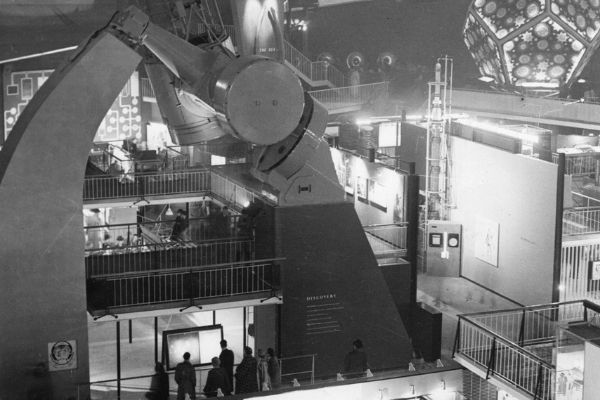What was the Festival of Britain and was it a success?
Hear how the festival planted the seeds for optimism in post war Britain and how Londoners are still benefiting from its legacy.

London Guided Walks » Episode 54: The Festival of Britain
What was the Festival of Britain and was it a success?
Hear how the festival planted the seeds for optimism in post war Britain and how Londoners are still benefiting from its legacy.

Your host: Hazel Baker
Hazel is an active Londoner, a keen theatre-goer and qualified CIGA London tour guide.
She has won awards for tour guiding and is proud to be involved with some great organisations. She is a freeman of the Worshipful Company of Marketors and am an honorary member of The Leaders Council.
She has been an expert guest on Channel 5’s Walking Wartime Britain (Episode 3) and Yesterday Channel’s The Architecture the Railways Built (Series 3, Episode 7).
Hazel Baker: Hello and welcome to London Guided Walks London History podcast. In the coming episodes, we will be sharing our love and passion for London, its people, places and history in an espresso shot with a splash of personality. For those of you who don’t know me, I am Hazel Baker, founder of London Guided Walks, providing guided walks and private tours to Londoners and visitors alike.

Festival of Britain 1951
As the centenary of the Great Exhibition approached, politicians had begun to ask whether a celebration in the same vein might operate as a tonic to lift the nation’s spirits.
1951 Britain was very different from the context in which the Great Exhibition took place. Britain had lost its sense of purpose and place in the world. The Second World War had sounded the death knell for the days of the Empire, which had been in a phase of steep decline since 1918. British pride in its Empire could no longer be sustained in the face of renewed and strident calls for independence by the subject peoples of its colonial holdings. Following the end of the war, a series of independence movements chipped away at the British Empire, leading to the establishment of new states such as Jordan, Burma, and Sri Lanka. In 1947, India, the Empire’s most prized possession, was partitioned, creating the two new, independent states of India and Pakistan.
Where the Great Exhibition had been a celebration of the British Empire and its international territories, the Festival of Britain needed to focus specifically on the British Isles. The years immediately following the end of the war had lost the triumphalist, proud tone of the age of empire, and a general sense of gloom and depression prevailed in public discourses. Post war Britain was a time of austerity, where rationing had continued, when 2 million people were unemployed and there was a shortage of foreign currency to buy food from overseas and the traumatic memory of the conflict as soldiers gradually came home and families began to rebuild their lives.
In 1947 a festival to mark the centennial of the Great Exhibition of 1851 was proposed to the house. In March 1948 the Festival of Britain Office was established, which would be responsible for coordinating festival events around the country.
Even before the Festival of Britain opened, it had been condemned as a waste of money. Sentiments were directed to the budget having better been spent on housing after the destruction of many houses during World War II.
The event organizers wanted to do something unique and progressive with the space, in order to create an iconic architectural statement that would stand for a new era. In line with this agenda, Hugh Casson, an ambitious architect, was put in charge of the construction and design of the Festival site, charged with putting together a team of young architects who would create a modern visual identity for the Festival. This was an important decision because it meant that the festival was, from the outset, imbued with an entirely fresh visual aesthetic that seemed to indicate the inception of a modern, British age.
This new festival with a budget of £12 million was intended to celebrate Britain as a nation and its achievements, “a tonic to the nation” as it were. It was called The Festival of Britain. The Festival was designed to focus British recovery rather than the joys and spoils of empire. The Festival was a reminder of British greatness on its own terms, empire or not.
But first things first…
What was the Festival of Britain?
3rd May 1951, King George VI declared The Festival Britain open with venues in London and across the country.
It was a national exhibition designed with the aim of promoting a feeling of recovery from both world wars. It was a large-scale demonstration of Britain’s contribution to civilisation; past, present and future in the arts, science and technology, industrial design and the viability of democracy.
Projecting and celebrating a sense of national identity was closely linked to Memory, remembering who the British were, which chimed with a national sense of place, as the rebuilding of Britain led to rethinking a national sense of place. This public declaration of unity, and forward-looking celebration of British achievement was precisely what was needed to reconfigure British identity in the radically altered post-war world.
Although it was a national event, the main focus for the event was a 27 acre area on the South Bank of the Thames in London, between Waterloo Bridge and County Hall. Bombed Victorian buildings and railway sidings which had been left untouched were transformed into a new public space which was intended to showcase the principles of design that would feature in the post-war rebuilding of London and the creation of new towns.
Over 2,000 locations were used with local authorities organising events as well as voluntary bodies. Several key projects and activities were made possible by Exchequer funds.
London locations included the South Bank exhibition site, the Exhibition of Science in South Kensington and the Exhibition of Architecture, Town Planning and Building Research at Lansbury in Poplar.
Upon its completion, the South Bank was made up of 22 free standing pavilions with themes around The Land and The People of Britain. It incorporated multiple levels of buildings, elevated walkways and an open plan feel.
Exhibitions included themes such as The Land of Britain, Sea and Ships, Power and production and The New Schools. The Skylon – an iconic, futuristic vertical cigar-shaped tower held in place by tension cables which gave the impression it was floating in mid-air. There was even a large Dome of Discovery which was at the time the world’ largest dome, being 365ft in diameter. Sound familiar? Today’s O2 (once known as the Millennium Dome) is also 365ft in diameter, the exterior was built to resemble the 1951 Dome of Discovery. The Dome housed exhibitions on the exciting themes of discovery such as Polar regions, the New World, the sea, the sky and outer space and had an entrance fee of five shillings. The festival was similar to a large-scale Tomorrow’s World.
One of the intended outcomes was to cheer everyone up. This public declaration of unity, and forward-looking celebration of British achievement was precisely what was needed to reconfigure British identity in the radically altered post-war world but that didn’t stop the critics. Once opened, critics turned their attention to the aesthetics; the Riverside Restaurant was seen as too futuristic.
The new open space on Southbank had a wide range of places to eat and drink; Restaurants (The Rocket, The Regatta and The Unicorn) , cafes (The Turntable Café and The Garden Café) and ornamental pools, some illuminated at night.
The overall theme of the Festival of Britain was ‘The Land and the People’ a national display of the interwoven serial story of Britain. This was a huge marketing campaign, not for the festival but for the country. Even with the critics’ comments, the main Festival site on the South Bank managed to attract more than 8 million paying visitors over its five month run.
Upriver from the South Bank, only a few minutes via boat, is Battersea Park. This was home to the fun-fair part of the Festival. This included Pleasure Gardens, walkways suspended in the trees, a water garden, and luxury shopping. Its focus was entertainment rather than education, which seemed to be the core purpose of the other exhibits, and consequently, it was widely enjoyed by large numbers of Festival visitors.
What is left of the Festival Britain in London?
Much of what was built for the Festival of Britain was temporary and after the event was dismantled. In both Wales and Scotland, little remains. In London some remarkable examples have survived, which is what I will be sharing with you today…
The Southbank
One could argue that the greatest legacy of the Festival of Britain is the stretch of former industrial riverside near Waterloo we call the South Bank. Since then it has grown to embrace the London Eye, the BFI and the Tate Modern (the most visited modern art museum in the world).
The Royal Festival Hall is one of the only buildings to endure past the end of the summer of 1951.This brand new concert hall, designed by Robert Matthew and Leslie Martin, was able to seat 2,900 people, and was constructed using reinforced concrete, luxurious timber and fossilised limestone, creating a modernist feel that was simultaneously organic. The extensive use of glass ensured that the Hall was bright and luminous during the day, and that it illuminated the wider South Bank site after dark. Particular attention was paid to the acoustics of the auditorium, which were designed to be state-of-the-art. The Festival Hall opened on the 3rd of May 1951 with a concert attended by the Royal family, to widespread critical acclaim. The dramatic beauty of the Hall’s interior impressed its early visitors, and ensured that the Festival would leave a monumental legacy on the South Bank. For some critics the Royal Festival Hall was seen as too innovative and even certain furnishings in the Café met criticism for being too gaudy.
The Skylon
Skylon is a name you will see on the Southbank but you won’t be able to see its originator.
Adjacent to the Dome of Discovery was the Skylon, a breath taking, iconic and futuristic-looking structure. The Skylon was an unusual, vertical cigar shaped tower supported by cables that gave the impression that it was floating above the ground. Some say this structure mirrored the British economy of the time having no clear means of support. The evening before the Royal visit to the main Festival site, a student is known to have climbed to near the top and attached a University of London Air Squadron scarf!
Some would describe the Skylon as a functionless structure in the shape of a rocket but it was the icon for the festival, a sleek, dynamic symbol of an exciting future for Britain. What became of the Skylon is unconfirmed. I have heard that it was demolished on the orders of Winston Churchill (the Labour government-commissioned Skylon was seen as a symbol of socialism).
The Skylon may be no more but it and its neighbours seeded a fascination for pointless iconic buildings. I have already mentioned the Millennium Dome offered a nod to the festival’s Dome of Discovery, one could argue Anish Kapoor’s ArcelorMittal Orbit, nicknamed the helter skelter, at the Elizabeth Park displays the same Skylon-style space-age name and aspirations.
Telekinema
One of the most popular attractions at the Festival of Britain South Bank site was the Telekinema, a 400-seat state-of-the-art cinema operated by the British Film Institute (BFI). It could screen films, 3D films and large-screen television and it was here that many visitors saw their first ever television pictures.
After the Festival closed in September of that year, the Telekinema became the home to the National Film Theatre, but this building was demolished in 1957 when the National Film Theatre moved to the site it still occupies at the South Bank Centre. The only existing building to be incorporated into the new site was a tall brick tower, built in the nineteenth century to make lead shot by dropping molten lead from a height. This was used to house a large radio telescope and transmitter.
Legacy of Art
The Festival of Britain was one of the first occasions where many women artists and designers had opportunities to take part. The famous sculptor Barbara Hepworth received two important public commissions; Turning Forms which was a motorised abstract piece, made of reinforced concrete, painted white and 84 inches (just over 2m) in height was commissioned by the Festival of Britain authorities. In 1952 it was moved to Marlborough Science Academy, in St Albans and in October 2020 was moved to a sculpture conservation studio for major conservation work.
Contrapuntal Forms which is a sculpture made out of Irish blue limestone. It was 120 inches (just over 3m) in height and was installed at the Dome of Discovery on the South Bank and commissioned by the Arts Council. In 1953 the Arts Council presented Contrapuntal Forms to the new town of Harlow in Essex. It is sited at Glebelands in Harlow.
One of the centrepieces of the festival was a new commission by the Arts Council for the artist Henry Moore. It became to be known as one of the great triumphs of his career. It was called ‘Reclining Figure” and was the first large reclining figure Moore had made in bronze. It now resides at the Scottish National Gallery of Modern Art, Edinburgh.
The original plaster sculpture from which the bronze was cast was given as a gift after Moore’s death to the Tate Gallery in 1978, along with 35 other sculptures.
‘London Pride’ (1950-51, c1987) by Frank Dobson
Commissioned by the Festival Design Group, the sculptor Frank Dobson created a work on the theme of leisure titled ‘London Pride’. He developed full-scale clay models at the Royal College of Art, London assisted by his students. The budget did not run to bronze, so the models were cast in plaster and finished in gun-metal. The finished work was originally erected at one of the entrances to the Royal Festival Hall on London’s South Bank site.
At the end of the Festival ‘London Pride’ remained in storage until 1986 when, at the behest of Dobson’s widow, the Arts Council arranged for them to be re-cast in bronze for a permanent public siting.
The sculptures were unveiled again on the South Bank in September 1987 on a new slate platform on Queen’s Walk, adjacent to the National Theatre so perhaps is the piece of art closest to its original spot.
Not far away is Sunbathers
Artist Peter Laszlo Peri was commissioned to create the sculpture ‘The Sunbathers’ for the Festival of Britain’s South Bank Exhibition site. It was located on the wall at the Station Gate, welcoming visitors to the Festival as they arrived from Waterloo station.
The sculpture had been considered lost but was rediscovered at a London hotel. The hotel’s owners had bought it at an auction in the 1950s and its significance as a rare survival from the Festival of Britain was forgotten. Historic England launched a campaign to restore ‘The Sunbathers’ and get it back on public display which saw them unveiled in 2020 at Waterloo Station, close to its original home.
Why has the Festival of Britain been largely forgotten?
The Festival of Britain has largely been forgotten these days. Why? This could be due in part to the immediate dismantling of Festival infrastructure in October 1951. Lets not forget that the Festival of Britain was vast and not really managed centrally, despite the official focus on London, which may have contributed to it being forgotten.
If it had been a high point in post-war national life it was quickly replaced in public memory by the accession of Elizabeth II and the excitement and preparations for the Coronation in June 1953.
Did the media play a part? Perhaps the fact that television was not well developed and there was no widespread media coverage that a festival of this kind would now receive may also have led to the Festival simply fading away.
Was the Festival of Britain a Success?
A new style and tone was set for the second half of the 20th century, and the visual aesthetic of the Festival represented the optimism that would accompany the Baby Boomer generation. These same visual aesthetics had a profound impact on planning, architecture, and development in London during the 1950s and 1960s, creating a new modernist style that was replicated throughout the city. In addition to this, South Bank site itself became a home for arts and culture within London. Today, the Southbank Centre occupies the Festival space and promotes a broad cultural programme of events and attractions.
Perhaps the Royal Festival Hall, the most iconic Festival building and the most public and civic building of London in the modern age and arguably the first modernist structure to be truly adopted by a city that was once proud to be conservative but which is now in love with the contemporary.
And so post-war Britain began to revive itself, focusing on domestic regeneration rather than the old ideas of Empire, and creating a new sense of hope for the nation’s future as it emerged from the shadow of war.
Perhaps the best answer to that question is that of English dramatist and writer Sir Arnold Wesker when asked about the festival “What do I remember? What everybody remembers: brave colours, exhilarating shapes, thrilling designs and the communication of courage. No, not quite, but rather that one has the spark of something within oneself. You know, like seeing a good musical, you came away feeling like you could dance just like [Gene] Kelly for a moment along the road.”